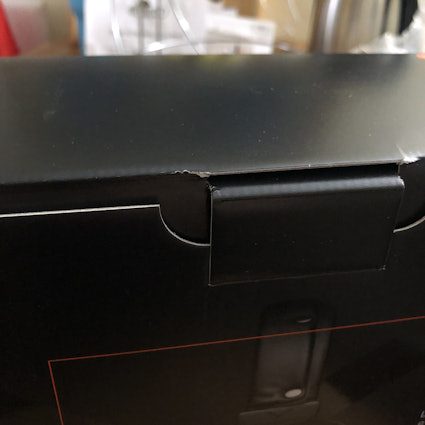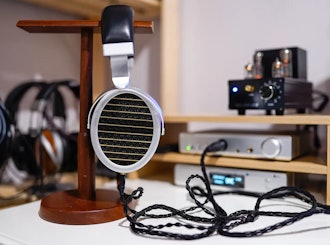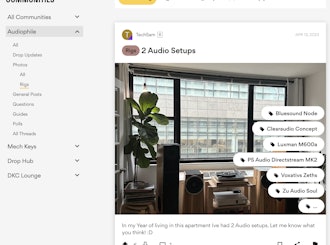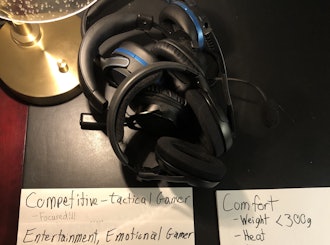Click to view our Accessibility Statement or contact us with accessibility-related questions





















Understanding Headphone Reviews

search
close
Sort by: Newest
keyboard_arrow_downAnalogStudio
0
Dec 25, 2024
Your analysis here is very interesting. I see that your explanations are really aligned with the wonderful physics. In Words of Caution, I realized that you are being very brave in reminding everyone that headphone analysis is quite subjective according to hearing and personal ability, without disregarding important technical data provided by manufacturers that are a reliable and solid basis for a better choice. A few years ago, I relied on these bases to reach the conclusion to choose my Beyerdynamic DT880 Pro Studio and I am satisfied with my choice, but I have a Koss Porta Pro to listen to music outside of my simple home studio. Thank you very much.
Hohdude
3
May 18, 2023
A great guide here. As a hard of hearing music lover, I find that sub-bass and bass ranges are too amplified for me; I have to tame these ranges further down and amplified the higher frequency ranges. My audiogram shows a ski-slope, meaning lower frequencies can be heard readily while mid to high frequencies are not. In terms of headphones without equalizers, I prefer AKG 701 with adjusted equalizer on my computer. Cheers.
k8ty
0
May 17, 2023
I got the beyerdynamic DT 990 PRO headphones and I was not happy at all when I received them. When I received them the box was already opened and had no seal. In the picture I attached, you can see that the tab was already ripped and there are no seals whatsoever around the box. These were supposed to be a gift for my boyfriend's birthday and now I am unsure that they even work since the box has already been opened. I can't even test them myself because I don't have the right adapter for the stereo jack plug. I paid $250CAD for a brand new headset, not this.


Bedlam-Inside
55
Sep 1, 2021
So, would IEM's claiming 'bone conduction' be Sub Bass as it's more felt? Or would it seep into the Bass level as well? Good little article though. Always good to 'translate the Greek' for folks!
(Edited)

Evshrug
4145
Keyboard Club Member
Dec 14, 2022
Bedlam-InsideGood question... hope you don't mind the late reply!
Bone Conduction drivers can produce a wide range of frequencies from bass to mids and some treble. Since the vibrations are traveling through the solids and liquids in your body, higher frequency notes lose their energy more than lower frequency notes, so they're usually paired with other types of drivers like Balanced Armatures (which are especially good with high notes) and Dynamic Drivers to kind of balance them out. That said, there are some headphones (such as the AfterShokz brand) that only use bone conduction drivers, even though they don't extend enough into the high frequencies enough to technically qualify as "hi res."
Regardless of driver type, "too much" bass or bass with a lot of resonance can "seep" and mask details in other frequencies. They all end up vibrating your eardrum and concha in the end!!

Ice_Trae
5
Jun 30, 2020
How can "Open" and "Closed-In" both be words to describe high frequencies? They sound mutually exclusive to me... I'm confused.

Ice_Trae
5
Apr 20, 2021
Yeah I clearly did not read the article in its entirety and now that I'm looking at it again that makes perfect sense.

Evshrug
4145
Keyboard Club Member
Dec 14, 2022
Ice_TraeIn your defense, it was a good line of questioning that directly lead to finding the answer!
Showing 15 of 21
Related Posts

Evshrug
Audiophile 101: Essential Gear Overview
Image credit @zhugunic https://drop.com/talk/67372/gl-2-k Do I need an amp? What are these acronyms like DAC, DSP, or DSD? What even are all the components that make up an audio chain? Let’s take a beginner’s look at the core, essential building blocks of a digital audio chain, and lay it plain what each piece does. We can cover the major pieces separately, but I’ll still include a few tips to optimize playback here. Please hit the little bookmark button and feel free to check and share this guide whenever you need a reference! For people who need a visual and audible explanation, or are worried it would take too long to get a working knowledge of the audio chain, here is my YouTube video on this subject that is just 7 minutes long! I like writing though, so let’s get started with an overview, then break it down into what each piece does and how an upgrade would benefit the final sound quality. Signal Path Image credit @SpeleoFool https://drop...
Mar 22, 2023
eyestech83
5 Ways to Fix Jio Cinema Not Working – Expert Tips for Seamless Streaming
If you’ve been trying to watch your favorite movies and shows on Jio Cinema, but things aren’t working as expected, jio cinema not working you're not alone. Streaming issues are common across platforms, but the good news is that many problems with Jio Cinema can be resolved with a few simple fixes. In this expert guide, we’ll walk you through five effective solutions to help restore your Jio Cinema streaming experience. 1. Check Your Internet Connection A stable internet connection is essential for uninterrupted streaming on Jio Cinema. Slow speeds, intermittent connectivity, or poor network strength can cause buffering, freezing, or even prevent the app from loading. What to do: Test your connection speed: Open a browser and run a speed test to ensure you're getting the bandwidth required for HD streaming (usually at least 5 Mbps). Switch between Wi-Fi and mobile data: If your Wi-Fi connection is unstable, try switching to mobile data. Alternatively, switching to a stronger Wi-Fi...
Nov 22, 2024

HoffmanMyster
New Feature—Product Tagging in Photos (+ Giveaway! - Audio Rigs Edition)
Ahoy, audiophiles! Hot on the heels of the launch event for the mech keys community, we are kicking off the Audiophile Rigs product tagging launch event (with a bonus giveaway for those who participate!). Check out all the Rigs submissions thus far! Audiophile Rigs What’s this about a giveaway? More details can be found at the end! The short version: we will be giving away $100 Drop Rewards credit to one lucky winner (randomly selected) from all participating users who contribute and tag their Audiophile photos using the "Rigs" flair! In order to be eligible for giveaway prizes, your photo must include at least two tagged items (not required to be Drop products—see Tagging Non-Drop Products below). Post must be made in the first two weeks (by 2023-05-10 11:59PM PT) in order to be entered. What is Product Tagging in Photos? Product tagging allows you to tag any products in a Photo post—both those found on Drop currently, as well as write-ins that will be manually approved and...
Apr 26, 2023

dekoni
Introducing Dekoni University
Dekoni Audio is excited to introduce our new Dekoni University video education series. Check back frequently to see our latest videos.
Aug 10, 2021

krist0f
DAC/AMP choice - please help
OK... I am going thru forums, reading and watching reviews for DAC/AMP combo for my pc and... seriously i do not know which one to choose. Here is my 'wish list'... maybe you can help... Main goal is to... like everybody i guess: listen to music / watch movies / gaming. Gaming is priority. I am not audiophile (sorry). But I do appreciate good sound quality. Wish List: will not 'break the bank' - preferable under $200... I would prefer it to have mic input but it is not a 'must' requirement. I would prefer it to be 'external' device. Not a must though. Need controls on the desk though. I would prefer it to work 'driverless'. So... hardware-based. I would like it to have some kind of hardware equalizer. I would like to be able to connect (computer) speakers and headphones the same time it does not need to be 5.1/7.1 etc. I prefer good stereo over these systems. Does anything like this exist? Closest to all checkmarks is Sennheiser GSX1000... i guess... not the newest technology...
Jan 5, 2021

Evshrug
Thoughts: The BEST Gaming Headphone for All Time?
Pairing up a gamer with the right headphone is a bit like playing matchmaker! In this video, linked at the end, I boil down over 10 years of community advice into 3 Personality types: • Competitive • Entertainment • Immersion I share a few keywords to look for, as well as some software and settings suggestions. I think everyone has a little bit of each type in them, but which type is dominant for you? Thanks to the sponsor of this video: DekoniAudio.com Dekoni is a headphone accessories company, unique for providing frequency response graphs on their website so you know what effect their various pad options will have. Thanks also to Drop for giving me permission to share here. I hope it helps everyone! The video: https://youtu.be/42SRsSlIj-c
Sep 29, 2020
Trending Posts in Audiophile

Hauntednsk
E-MU Teak Repair - Any Experience?
Hello, I am wondering if anybody has any experience contacting E-MU support, sending them headphones for repair, or getting them back fixed. Can anybody share any experience? I have been emailing them for a while now, but nobody has responded. Thank you.
Dec 29, 2024

murphdc
pc38x still has audio coming through with the volume dial turned all the way down
Finally got my hands on the pc38x. I mostly wanted to try this headset because of all the good things i heard about it. Out of the box i wasn’t really impressed. My 50 dollar astros were just as loud if not louder. After setting up an EQ on dolby access i got them sounding a little better. But one thing that really bothers me is the volume dial on the headset. When i turn it all the way down there’s so much audio still coming through, like the headset is turned up 10-20%. Is this normal?
Dec 28, 2024

MrChiSox
My little room work in progress.
It's not done, I apologize for the mess. Health issues have put this on hold. It's a small room and I'm likely to sell off my KEF 104.2 loudspeakers and some other gear after surrendering the living room to my wife after her patience of 35 years. She deserved her own little sanctuary.
Dec 26, 2024
magica
What lead/cable do i need?
i own a Drop + EPOS PC38X Gaming Headset and i need a new cable that connects the headset to the computer. i dont know what its called and i cant work out what to look for on amazon etc. could someone please help me with this
Dec 21, 2024

MrChiSox
New addition to the stable.
I made the decision to take advantage of the $600. price on the HiFiMan Arya Stealth, here pictured with the Meze 109 Pro. I think 2025 is going to be a really uneventful year so far as new purchases. I've also upgraded my Fiio BTR7 to the newly released BTR17 and I purchased the Earmen stack which consists of Amplifier, Linear PS, DAC & Streamer.
Dec 19, 2024

RNT47
Until when will the Sennheiser 58X and 6XX will be at discount price?
I'm planning on buying either one on the 18th and i'm worried i'll miss the discounted prices
Dec 16, 2024
bill.davies
BMR2 discounts for BMR1 owners
How about providing a BMR2 discount for BMR1 owners? Most of the "improvements" in the next gen should really have been there in the first which was a pretty big disappointment for most of us. UPDATE: 40% discount offered. That's great, I'm in. Thank you DROP.
Dec 3, 2024






As with any expensive electronic product, doing research and reading reviews on headphones is a good way to reduce the risk of buyer's remorse. Physical characteristics such as the build quality, comfort, and accessories are easily described and understood, but when it comes to describing how something sounds - that's a whole other ball game. Understanding the frequency range of sound and how it affects the music is a great running start towards understanding your own preferences and what sound signature of headphone is best for you.
The Spectrum of Sound
The deep rumbling of a bass guitar. The lively tweeting of a piccolo. Both of these sounds begin as vibrations, carried through the air from the instrument to your ears. As the speed of vibrations is directly correlated to pitch, the low notes on the bass guitar vibrate the air slowly as compared to the higher notes on a piccolo. Measured in Hertz (named after the German scientist who proved the existence of electromagnetic waves), both the bass guitar and the piccolo fall within the audible range of human hearing, approximately 20 Hz to 20 kHz. This spectrum makes up the desirable range of sound for a headphone/IEM/speaker to electronically reproduce.
Instruments on the Frequency Range
Independent Recording Network has created a fantastic, interactive chart (http://www.independentrecording.net/irn/resources/freqchart/main_display.htm) that breaks out and describes the spectrum. The breakout into each range is somewhat subjective and varies based on who is asked, but this serves as a good general guideline.
Sub bass: <60 Hz
Sub bass is a powerful rumbling that is more felt than heard. Here are the chest thumping vibrations that give songs impact. Sub bass is difficult to hear at low volume levels, but too much of a boost results in a muddy-sounding lower end.
Words to describe this range: Rumble, Thump, Power, Weighty, Muddy
Bass: 60 Hz – 250 Hz
Rhythm driving instruments such as the kick drum, toms, snares and bass guitar can be tweaked in this range. Most mainstream music today heavily uses the 90 Hz-200Hz area to color the lower end. A boost here adds warmth and thickness, but too much of a good thing makes music sound boomy and drowns out the rest of the frequency ranges.
Words to describe this range: Tight, Warm, Slam, Thick, Boomy, Bloated, Thick, Thin
Midrange: 250 Hz – 2,000 Hz
250Hz to 500 Hz is where low order harmonics of most instruments lie. Boosting the lower midrange can make bass and lower-stringed instruments sound clearer, but too much can cause higher frequency instruments to sound muffled. 500 Hz onwards has a significant impact on how human vocals sound. Done correctly, male and female vocals should sound lush. Boosting too aggressively turns music syrupy and/or shouty, whereas a recessed midrange causes vocals and instruments to sound distant and far.
Words to describe this range: Fullness, Hard, Honky, Lush, Tinny, Recessed, Muffled, Syrupy, Shouty
Upper midrange: 2,000 Hz – 6,000 Hz
The attack on percussive and rhythm instruments like cymbals are dependent on this range. A well-executed upper midrange adds clarity and has a positive effect on the sound timbre. Excessive boosting causes glare and sibilance, but not enough and music sounds dull and dark.
Words to describe this range: Clarity, Sibilance, Glare, Bright, Edge, Crunch, Dark, Dull
High frequencies: 6,000 Hz – 20,000 Hz
At this range, harmonics are all that's left. High frequencies done right make songs sound airy and open. Over boosting can make music overly bright and fatigue listeners, not enough makes music sound closed-in and soft.
Words to describe this range: Airy, Open, Definition, Sibilance, Bright, Closed-in, Soft
It's worth noting that reviews online should be taken with a grain of salt. While we've described the spectrum as well as the words most associated with them in reviews, it's an individual's subjective opinion. People have different tastes - just because a respected reviewer showers a headphone with praise doesn't necessarily mean you'll like it. Similarly, just because people speak scathingly about a headphone doesn't mean it can't be a great product to your ears. In the end, reviews should only be used as an initial guide on your road to finding your perfect (headphone) match.
Other Cool Sites to Check Out
We've only just touched on the frequency range and words you might see in a typical audio review. For more information, visit the websites below.
http://www.headphone.com/pages/evaluating-headphones - A dive into understanding headphone measurements, what is desirable, and other helpful graphs.
http://www.audiocheck.net/soundtests_headphones.php - Offers several interesting headphone tests ranging from frequency response to dynamic range to a bass shaker.
http://www.zytrax.com/tech/audio/audio.html - Read up on technical information regarding frequency ranges.
http://www.stereophile.com/reference/50/ - A glossary of audio review terms according to Stereophile.
Image #2 credit: Turntable Lab (http://www.turntablelab.com/pages/headphone-buying-guide-frequency-response-for-headphones)
"Understanding Headphone Reviews" was written by community member Daniel Lui (https://www.massdrop.com/profile/Danny_Liu).